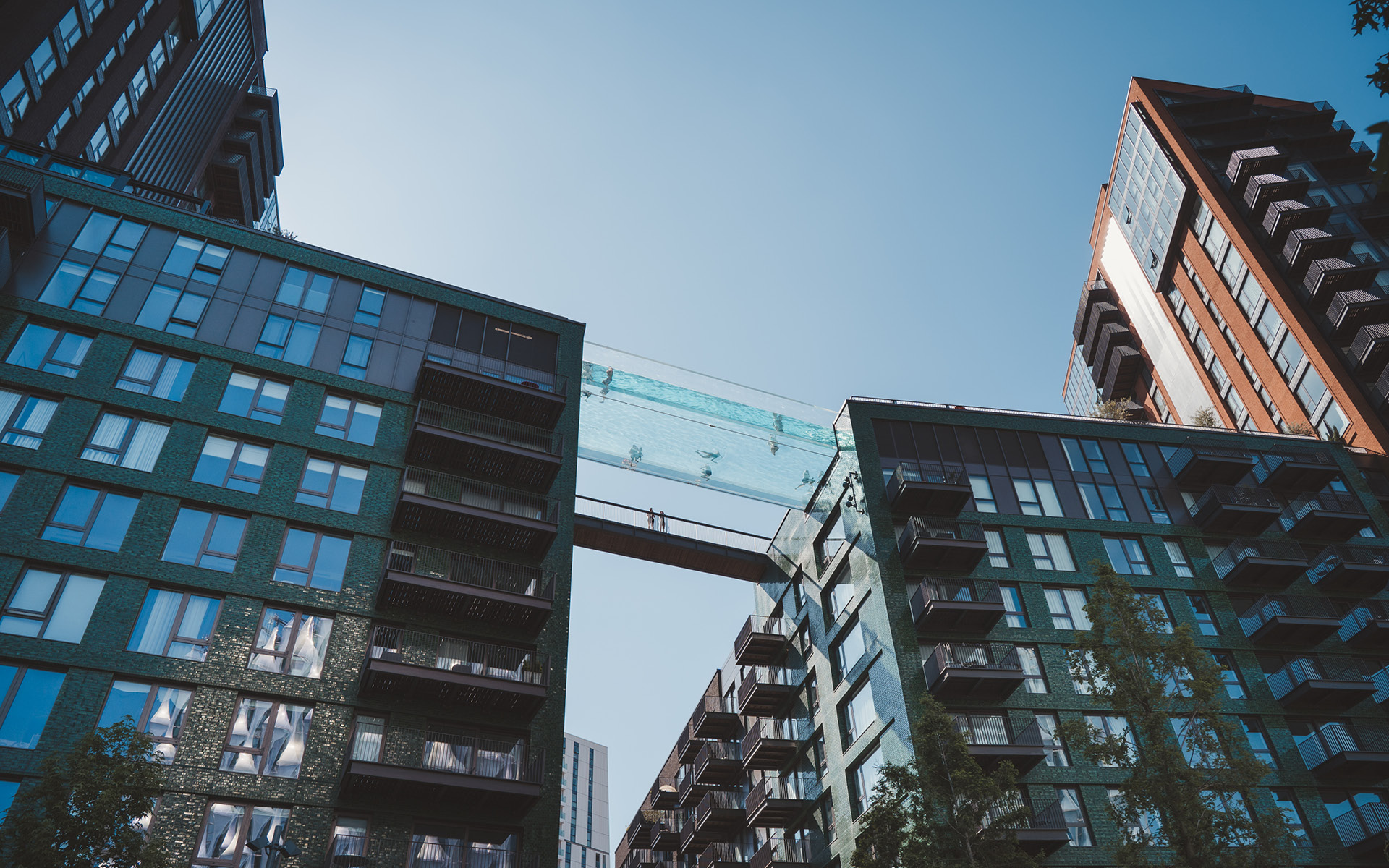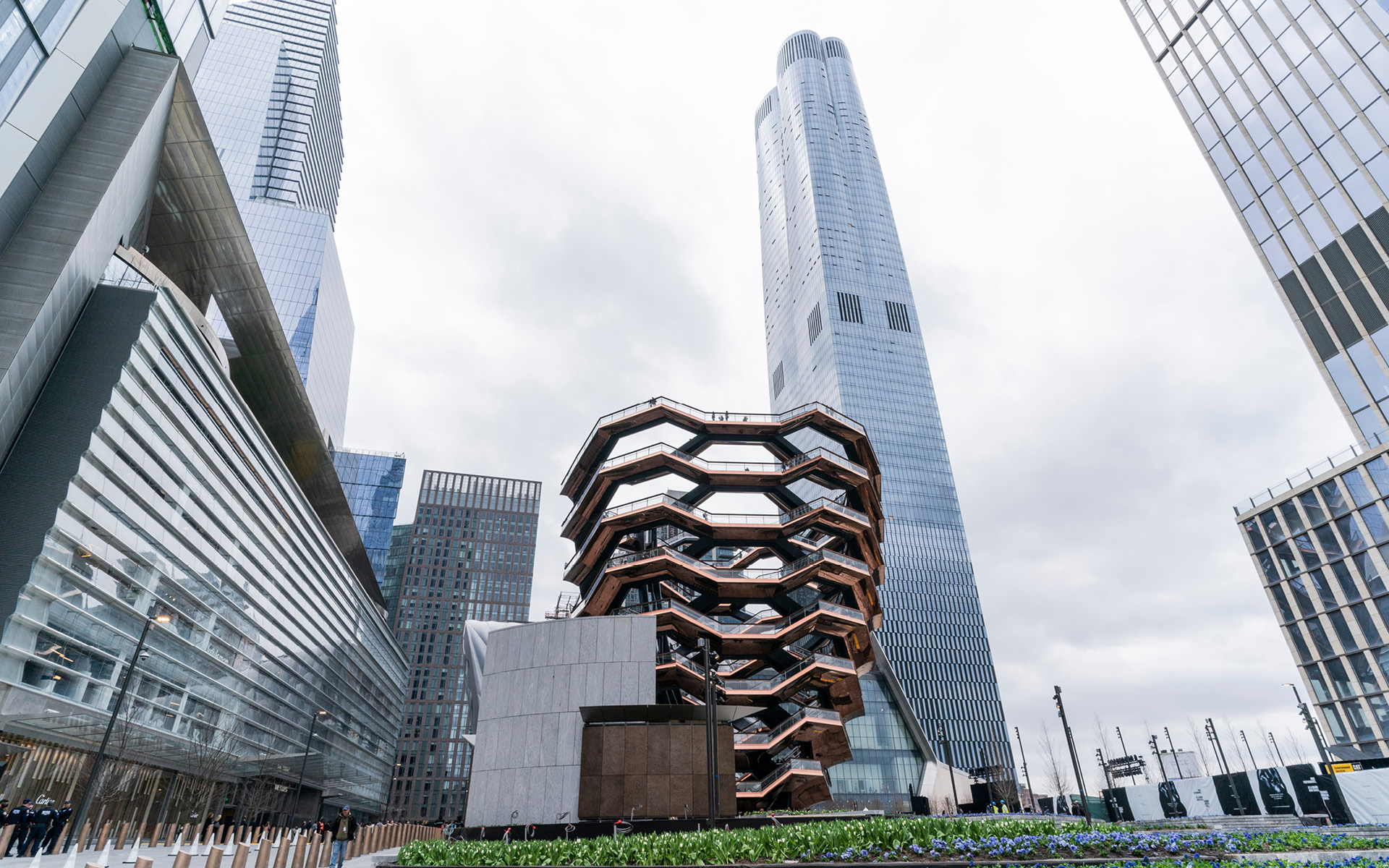
Swimming pool bridge in Embassy Gardens, London, UK
One of the most overused words in real estate is ‘exclusive’. But were you to seek out a development that embodies this, you would be hard-pressed to find a starker example than Embassy Gardens, built on a formerly unloved sweep of land in south London, between Battersea and Vauxhall.
The development is famous for the glass swimming pool that is suspended 35m above ground between two of its buildings, hailed as the first of its kind and the sort of decadent piece of architectural bling that foreshadows the fall of empires. On a wintry, windy day, the waves slapping against the sides, it looks like a facility that most residents could pass on.
What is of more an attraction is the lobby, a generous sprawl of gentle lighting, polished wood and low, pale sofas set around a vast concierge desk, like something from an upmarket hotel rather than a block of flats. How lovely for the residents of this imposing residence. Well, how lovely for most of them because, tucked around the back of Embassy Gardens, in the shadow of the railway arches and the service road is the rather more utilitarian door that residents of the scheme’s affordable housing units must use.
There’s nothing intrinsically wrong with this entrance, it’s just somewhat more functional than the main one: stark strip lighting, hides-the-dirt carpet, plain white walls. It is only the placement of mailboxes just inside that confirms that this is a main door and not an extra fire exit.

The haves and the have-nots?
Welcome to the world of segregated entrances for the wealthy and the not-quite-so-wealthy (it is worth remembering that so-called affordable housing can still be charged at 80% of market rate in London, making it out of reach for most). ‘Poor doors’, as they have been dubbed, have been a feature in London and New York for some time: laws oblige developers to set aside some units for affordable housing in the former and local tax breaks incentivise its provision in the latter.
Nevertheless, Embassy Gardens is an egregious example. And despite vows to outlaw them on both sides of the Atlantic, cities such as Vancouver, Washington DC, Toronto and San Francisco – where property values have outstripped wages – have also seen plans for what are coyly referred to as “different access points”.
But why build like this?
“People say that poor doors are a financial necessity to provide mixed housing, but it isn’t mixed housing if it’s allowing segregation. They're a really visible sign of the inequality that many people face,” says Fran Darlington-Pollock, chair of the Equality Trust, a charity that campaigns against social and economic inequality.
“We’re allowing property developers to dictate our views of how housing should work. There’s no foundation for poor doors other than the developers’ wish to maintain profit. It’s morally bankrupt and we have given them too much power.”
Her clear indignation is shared by many including some residents who, understandably, can feel stigmatised. At 15 Hudson Yards, for example, a riverside tower in Manhattan, three affordable-housing tenants are suing the developer, alleging discrimination that they must use a poor door. “I’m never going to let someone make me feel like a lesser person because I don’t make $100,000 a year,” says Chanel Moody, one of the people bringing the action.
And truthfully, the perception of the poor door could not be worse, both for the developers and the building’s private residents who are often – unfairly – accused of not wanting to share communal areas with their affordable-housing neighbours. Housing being a touchpaper issue only makes the matter worse.
A complicated situation
But this is where the issue becomes a little blurred because developers complain that the matter is completely out of their hands. That it would be pointless to offer the level of facilities that are provided for their private occupants if the affordable-housing residents cannot pay for them. Ballymore did not provide a figure for Embassy Gardens’ service charge but newspaper reports earlier this year quoted one resident complaining that he paid more than £6,500 a year and the figure was rising steeply.
Instead, developers blame the housing associations that take on the affordable units and who, they say, take the decisions about what will and won’t be provided on-site for their residents, including even the possibility of opting into services.
“The affordable rent properties at Embassy Gardens are owned and managed by the housing association Optivo,” said Ballymore in a statement to Modus. “Before acquiring these homes, Optivo had the option to choose which amenities it wanted to buy into for its future residents. To keep its service charges as low as possible, Optivo opted out of certain amenities, including the cinema, health club, concierge, valet and main lobby access, which led to the introduction of a separate entrance lobby for their residents.”
“People say that poor doors are a financial necessity to provide mixed housing, but it isn’t mixed housing if it’s allowing segregation." Fran Darlington-Pollock, Equality Trust

Access to better neighbourhoods
In New York, where qualifying tenants enter a lottery for the affordable homes provided in new developments, the provision of poor doors are built into the tax breaks that allow them: the 421A code mandates that the affordable housing is kept separate.
But there is also a pragmatic argument that, however distasteful the idea of financial segregation is, ultimately the provision of affordable housing is socially beneficial and separate entrances should be, if not embraced, at least tolerated.
"We shouldn’t worry as much about poor doors – we want these homes built in the right neighbourhood,” says Rick Jacobus who heads the California-based consultancy Street Level which advises organisations on inclusivity around planning and development. “The primary advantage is the access to higher-income neighbourhoods that they give and, in America, that means schools.
“Good neighbourhoods change outcomes for lower-income people: their children will be healthier, have cleaner air and better amenities. None of these things require them to share a hallway with a rich person. People imagine that residents are rubbing shoulders with the richer neighbours, and it rubs off on them and that’s condescending. It’s about access to [the richer] neighbourhoods – there’s not much rubbing off happening in either direction.”
Poor doors may be very far from perfect, but they do allow a small degree of ‘levelling up’ and, for all the justifiable outcry that they cause, the current alternative is lower earners confined to badly-resourced neighbourhoods or finding themselves unable to hold on in areas that are rapidly gentrifying. An entrance round the back of a building in a safe, economically-vibrant area or equal-opportunities access to a run-down and disadvantaged one – it may not be much of a choice but, for most people, it’s an easy one.
"We shouldn’t worry as much about poor doors – we want these homes built in the right neighbourhood” Rick Jacobus, Street Level


